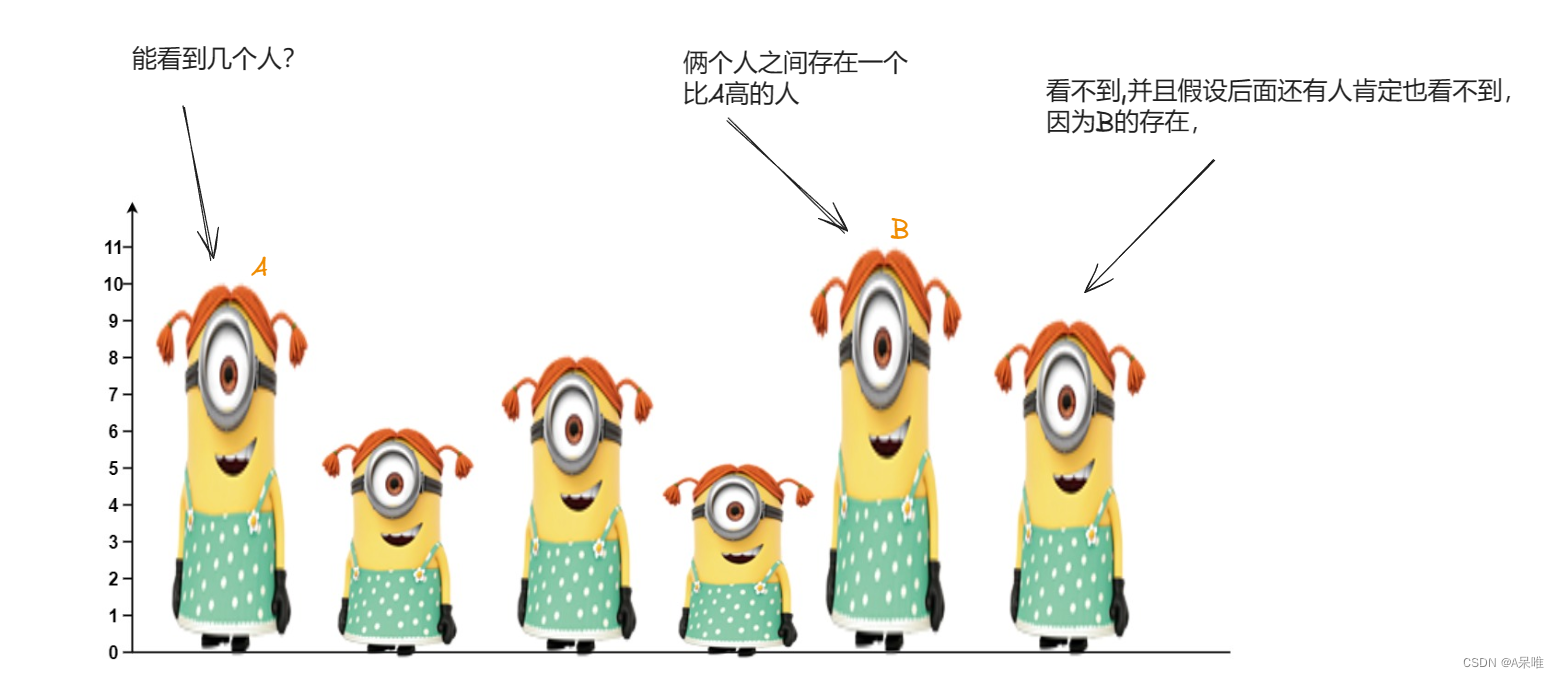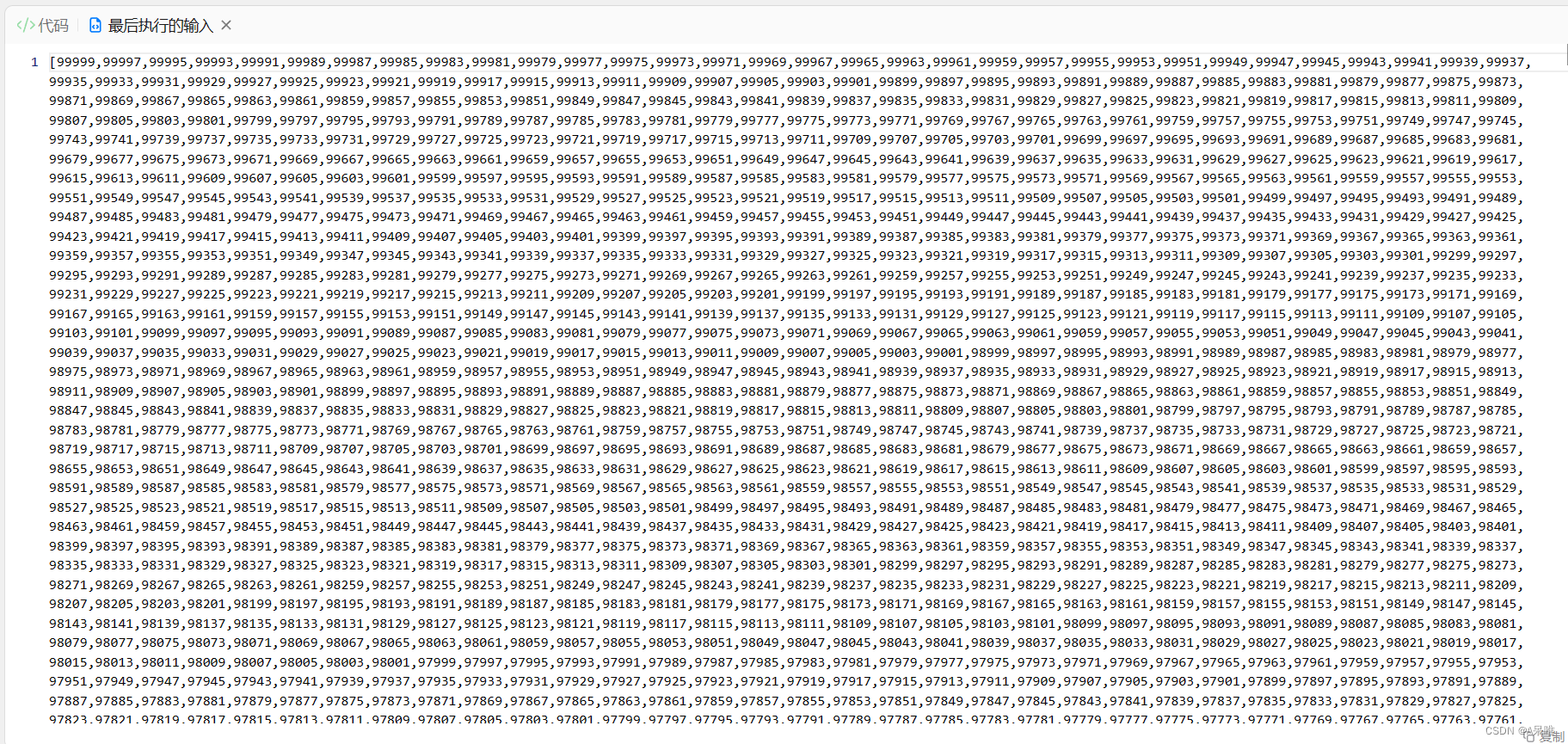力扣1944.队列中可以看到的人数--单调栈
发布时间:2024年01月05日
思路:
- 由题知一个人能?看到?他右边另一个人的条件是这两人之间的所有人都比他们两人?矮 ,也就是说,在自己右边第一个比自己高的人后面的人就肯定看不到了

- 那么只需要找到右边第一个比自己高的人与自己之间的所有满足要求的人就行了,怎么找?一个个判断中间是否有不满足要求的人吗?可行,但太慢。通过分析,不难发现在此区间内满足要求的人身高呈递增增长,也就是说,只要左边有比自己高的人那么这个人肯定看不到:

- 那么只需要判断指定范围内每有一个满足条件的人就将能看到人数加一就行了
代码:class Solution { public: vector<int> canSeePersonsCount(vector<int>& heights) { int len = heights.size(); vector<int> answer(len); //记录每个人可以看到几个人 for(int i = 0; i < len - 1; i++){ //遍历除最后一个人外的每一个人,因为最后一个人能见人数肯定是0 if(heights[i + 1] >= heights[i]){answer[i] = 1;continue;} //如果右边第一个人就比自己高,直接记为1,跳过此次循环 answer[i] = 1; //记录当前人可见人数,因为已经判断右边第一个人,所以初值为1 int t = heights[i + 1]; //记录左边的最高人,初值为当前人右边的人 for(int j = i + 2; j < len; j++){ //从当前人右边第二个开始判断是否可见 if(heights[j] >= heights[i]){answer[i]++;break;} //遇到比当前人更高的人,记录,并退出遍历 if(heights[j] < t) continue; //如果左边有比自己更高的人,则跳过 t = heights[j]; //如果没有,则自己为当前最高的,更换最高人 answer[i]++; //记录,能到这里,说明满足条件 } } return answer; } }; - 这个方法是我一开始的想法,没有问题,但是......
 ?
? - 真狠啊

- 显然O(n^2)是不行了,那么就得想一个更快的方法。通过分析,不难发现在之前的方法里可以优化的点是:对于某个人,只要他左边有一个比他更高的人,那么在那个比他更高的人之前的所有人都看不到他
- 也就是说,对于某个值,只要把能看到他的人都记录完,此时他就不被需要了可以忽视了,也就是说可以使用一个栈将每个值记录,对于不再被需要的值就弹出,在弹出的过程中刚好记录可见人数,同时将维护单调栈,从栈底到栈顶,身高严格递减
假设输入为heights = [10,6,8,5,11,9],对于这个输入——
i h[i] 入栈前 入栈后 可见人数 解释 5 9 [] [9] 0 4 11 [9] [11] 1 11挡住9,弹出9 3 5 [11] [11,5] 1 2 8 [11,5] [11,8] 2 8挡住5,弹出5 1 6 [11,8] [11,8,6] 1 0 10 [11,8,6] [11,10] 3 10挡住8,6,弹出8,6
代码:
class Solution {
public:
vector<int> canSeePersonsCount(vector<int>& heights) {
int len = heights.size();
stack<int> stack; //栈
vector<int> answer(len); //记录可见人数
for(int i = len - 1; i >= 0; i--){ //从最后一个开始压栈
while(!stack.empty() && stack.top() < heights[i]){ //如果栈不为空且栈顶元素小于当前要压栈元素
stack.pop(); //弹栈
answer[i]++; //记录
}
if(!stack.empty()) answer[i]++; //若栈不为空,则代表当前要压栈元素后边还有一个比之更高的人可见,记录
stack.push(heights[i]); //压栈
}
return answer;
}
};??
文章来源:https://blog.csdn.net/m0_71386740/article/details/135418169
本文来自互联网用户投稿,该文观点仅代表作者本人,不代表本站立场。本站仅提供信息存储空间服务,不拥有所有权,不承担相关法律责任。 如若内容造成侵权/违法违规/事实不符,请联系我的编程经验分享网邮箱:chenni525@qq.com进行投诉反馈,一经查实,立即删除!
本文来自互联网用户投稿,该文观点仅代表作者本人,不代表本站立场。本站仅提供信息存储空间服务,不拥有所有权,不承担相关法律责任。 如若内容造成侵权/违法违规/事实不符,请联系我的编程经验分享网邮箱:chenni525@qq.com进行投诉反馈,一经查实,立即删除!
最新文章
- Python教程
- 深入理解 MySQL 中的 HAVING 关键字和聚合函数
- Qt之QChar编码(1)
- MyBatis入门基础篇
- 用Python脚本实现FFmpeg批量转换
- VSCode无法下载插件,提示 Error while fetching extensions : XHR failed
- uniapp+vue3+ts--编写微信小程序对接e签宝签署时跳转刷脸效果(人脸识别)中间页代码
- N-138基于springboot,vue在线教育平台
- 推荐github热榜项目_crewAI
- SAP-PP:Phantom Assembly 虚拟装配 概念理解
- 位操作符详解(C语言)
- 从0到1,产品经理如何提升市场敏锐度?
- docker 安装elasticsearch、kibana、cerebro
- Python 中的字符串分割函数 split() 详解
- uniapp 使用uCharts图表组方法